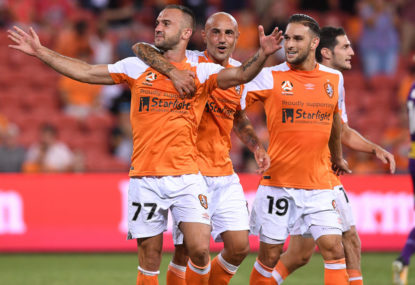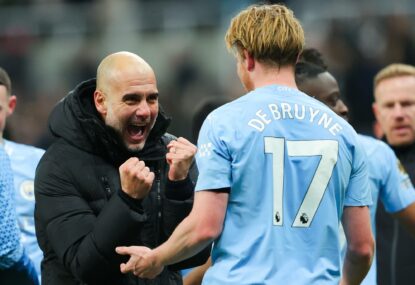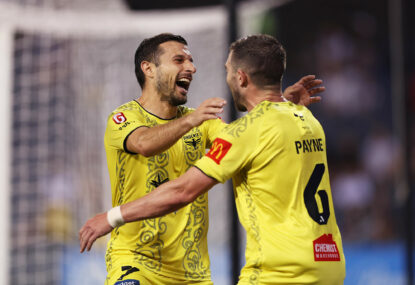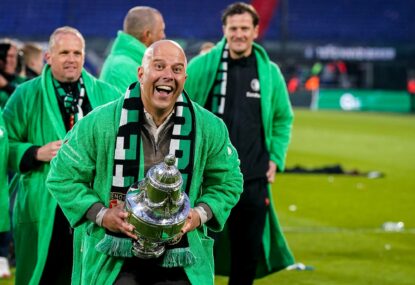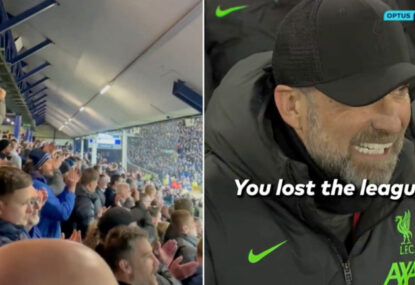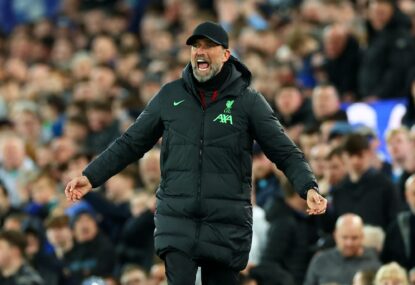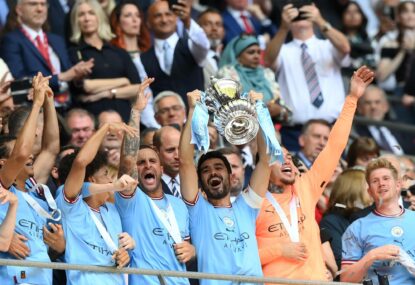So, to the bottom half we look, a collection that mixes the also-rans with the oh-dear-I’ve-fallen-overs.
There has been a slight improvement on last season; only Wellington and Central Coast have been truly cut adrift at the bottom, nine or more points from the finals, whereas this time last season there were three teams so placed.
Let’s grind through the rest of that gut of mediocrity then, sifting for anything of note.
Western Sydney have rarely managed to put together consecutive coherent performances this season; only once have they managed back-to-back wins this campaign. In fact, their results from February 4 until March 24 read: W-D-L-W-D-L, a remarkably consistent spell of inconsistency.
There are rumours the club are thinking of welcoming back Tony Popovic – relieved of his duties at Turkish club Karabukspor after just two months – which, if based on the progress Josep Gombau has – or hasn’t – made since joining last November, would be very odd indeed.
Gombau isn’t a quick-fix manager, he’s a steward whose methods take time to introduce, and who tends toward a bottom-up revamp.
There are some encouraging signs anyway.
Gombau recruit Chris Oikonomidis has provided a hugely necessary injection of on-the-ball incision – in just nine games played, he already leads the team in tackles evaded and has scored three goals.
The development of Kearyn Baccus is pleasing too – of all A-League midfielders to have attempted 1000 or more passes this season, no one has passed at a higher rate of accuracy than Baccus (87%).
Another interesting quirk in the numbers: Raul Llorente is one of the league’s most prolific and least-accurate crossers at the full-back position; he has banged in 98 crosses this season, third most among defenders, but has successfully completed just 16, a rate of 17%.
Although Oriol Riera is one of the most dominant aerial forwards in the division – he is inside the top three for aerial contests won among forwards, and his opening goal in the November Sydney derby was a rip-snorter – Llorente might still want to work on his delivery.
It would be hard to write up a numbers-based paragraph about Brisbane without mentioning age, which is just a number, but, well, that’s why we’re here, aren’t we? Brisbane fielded the oldest starting XI this season; in fact, they fielded eight of the top ten oldest starting XIs, the most aged of which included 27-year-old Jack Hingert as its youngest member.
There is nothing wrong, in theory, with relying on experience; Sydney are a very old team too, and it’s certainly helped them. But in February, when John Aloisi fielded a team the average age of which was 33.4 years old, he smashed the previous record by more than a year, and then re-broke the record the next round against Newcastle.
How do we reconcile this with the fact that Brisbane have performed at a markedly higher level in the tail end of the season, earning 0.40 more points-per-game over their last eight matches than they did on average over the rest of the season?
They enter the final round knowing that if Adelaide beat Western Sydney, a win against Perth would see them safely into the post-season. Furthermore, only six players in the entire league have played more minutes than 38-year-old Massimo Maccarone. These old fellas still have some energy left in them!
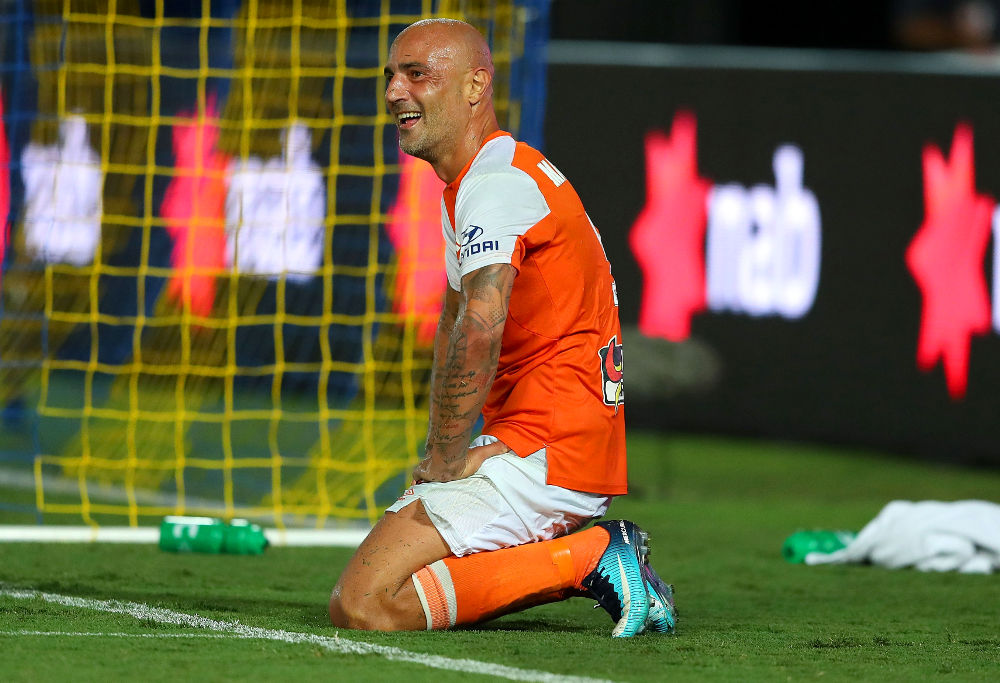
(Photo by Tony Feder/Getty Images)
What also stands out about Brisbane is how few shots they have taken this season (278), with only Central Coast shooting less often. They’ve managed to shoot accurately in spite of this limited volume, but it hasn’t led to goals – the bottom two are the only teams to score fewer than Brisbane’s 30 goals this season.
Outside of Maccarone, Brisbane have not got a cutting edge, and it’s not a good sign when your centre back, Avraam Papadopoulos – who has missed 11 games through injury or suspension – is your third-leading scorer.
Ah, Perth, here we are again. Last season, Kenny Lowe’s kamikaze legion finished the campaign with the second-most goals scored – an incredible 53 – and the equal-most goals conceded – again, an incredible 53. This glass cannon of a team then went and played as such in the finals, blowing City away 2-0 in the first round, before being crushed 3-0 by Sydney in the second.
This season, Perth have the second-worst defensive record in the division – 47 goals conceded, with only Wellington worse – but have slowed down offensively, with just 35 goals to their name, good for sixth best. Much of this can be blamed on the fact that Adam Taggart, Andy Keogh and Diego Castro have missed a combined 20 games this season, albeit most of those being Taggart alone.
Still, they managed to squeeze in some hockey scores along the way nevertheless; 19% of their matches saw the teams combine for five or more goals, a percentage bettered only by Sydney FC – by virtue of their scoring freely – and Wellington – by virtue of their conceding freely.
The 5-2 defeat to Wellington in November, the 6-0 defeat to Sydney in December and the fact Perth lost three matches this season by a scoreline of 3-2 all show the Kenny Lowe method hasn’t lost much of its volatility.
Here’s a concerning stat; Perth have also conceded more penalties (9) than any team in the league, with Joseph Mills and Liam Reddy responsible for four penalty concessions between them; that’s as many as the Phoenix have burped up as a team. Yikes.
I wrote about how furiously and how ineffectively Central Coast passed the ball this season back when Paul Okon left. Their use of the ball was the true definition of tiki-taka, which has been misunderstood as describing a sort of Guardiola-esque possession-based potency, but what originally was meant as a sneering jeer aimed at football teams that passed and passed and passed to no real end.
So let’s look at something else: how about Andrew Hoole, who for the second year in a row was seemingly one of the most dangerous attackers in the league, but who had a relatively meagre impact on his team’s offensive potency. Obviously, Hoole’s was hampered by not playing alongside a capable striker; in Central Coast’s best game, the 2-0 win over Sydney, Paul Okon subbed his starting striker Kwabena Appiah-Kubi at halftime, such was his irrelevance.
Hoole leads Central Coast in goals and assists, in shots on target, and he’s played the most balls into the box (178) this season among the Mariners, well over double the amount of second-placed Connor Pain (78).
He’s also the second-most fouled player (68) in the league. These numbers seem to indicate Hoole is a great attacker, so then why the limpness when it comes to tangible impact?
Well, that’s because Hoole flatters to deceive; he’s been dispossessed more times than anyone in the league, crosses with middling accuracy, and has registered zero secondary-assists.
Hoole tends to dribble, look to beat players and either score or pass to a teammate, regardless of whether a slaloming run is the best thing to embark on in the first place. The counting stats look good at first glance – shots, fouls, dribbles, etc – but those numbers are inflated by the Mariners’ possession system; he and teammate Daniel De Silva rank fourth and third for total possessions among forwards (1041 and 1061 respectively) but have done so little with those possessions relative to their league counterparts.
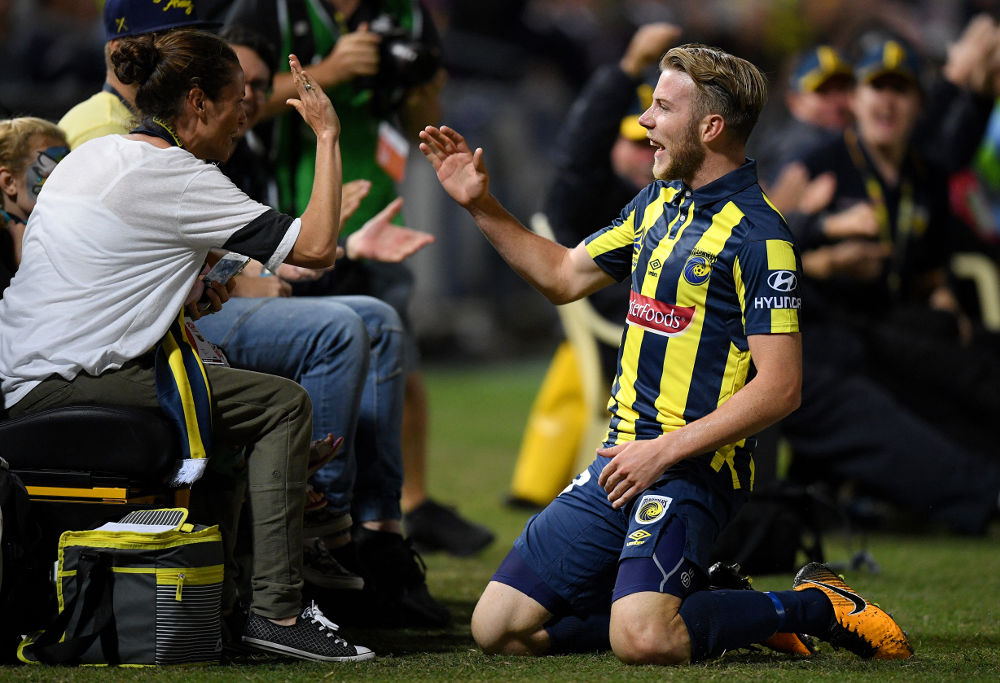
(AAP Image/Dan Himbrechts)
Combined, Hoole and De Silva have 14 goal-involvements this season, which is fewer than Wellington’s Roy Krishna has on his own, and only four more than Daniel Arzani has managed in six fewer matches. Is this Hoole and De Silva’s fault, or have they just been labouring under a generally ill-fitting system that forced them to play this way?
Finally, and briefly, to Wellington. If they finish the season with their current goal-difference (-25) it will be their worst figure since entering the competition in 2007. If they lose or draw to City this weekend, their points total (18) will also be their worst ever tally.
The club so often derided as the unwanted appendix of the league is close to rupturing, and conversations around league expansion are now seriously incorporating the idea of Wellington’s ejection. There has been talk of Wellington’s abject failure to meet off-field metrics required by the FFA in order to extend the club’s license at the end of the 2019/20 season.
It seems unlikely the Nix will fulfil those obligations before that decision is made. All this seems a shame too, especially when Sarpreet Singh has just strode into their first XI as a talented young Kiwi. Singh, in an admittedly small sample size (10 games), is making more key passes-per-90-minutes than James Troisi, Eric Bautheac or Isaias.
The 19-year-old has rare poise on the ball and needs to develop in the best possible environment. New Zealand are batting well above their average in world football; Winston Reid, Chris Wood, even Marco Rojas – all these players would be in contention for Socceroos places if they were Australian.
New Zealand football needs a healthy Phoenix, but it seems their state is one of near-constant sickliness.
The finals will surely offer up some genuinely compelling, thrilling contests; it always does, and don’t forget the big tourney that begins in June. Until then, though, we can ruminate on this season, rolling it around our minds, hoping for something to imprint itself.
Pass completion statistics won’t live long in the memory, but that Nabbout howitzer against Sydney will.





























































































